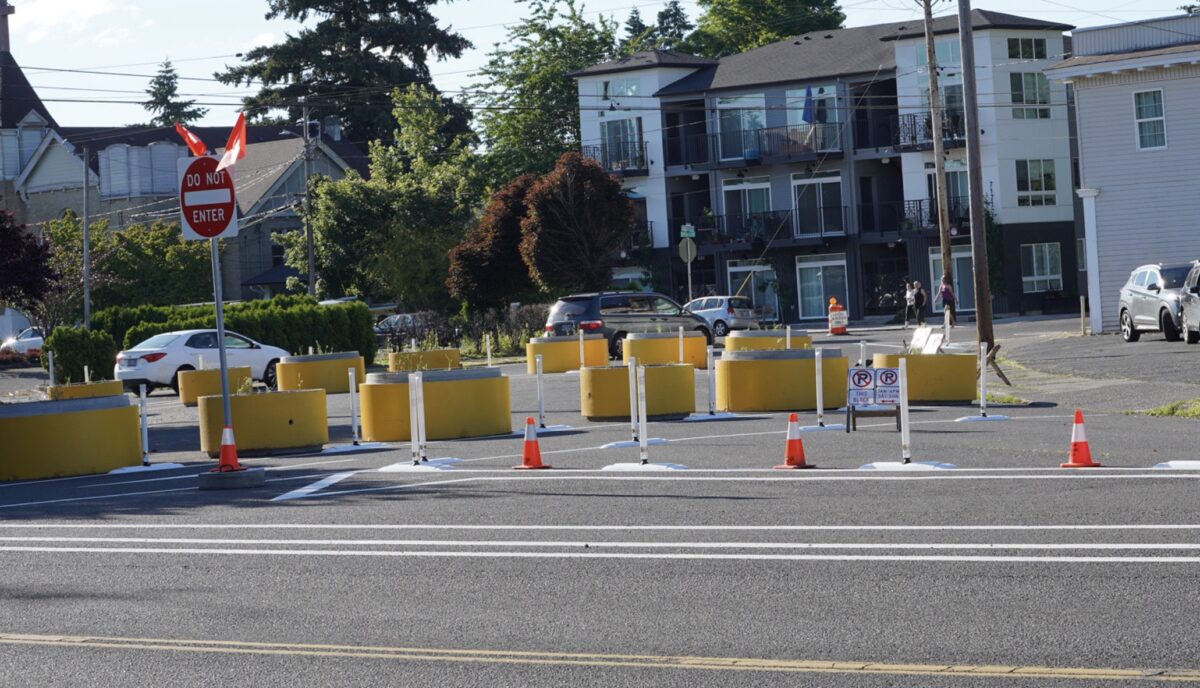
(Photo: Jonathan Maus/BikePortland)
When multiple bureaus at the City of Portland came together with concerned residents on a novel approach to address a disturbing rise in shootings and speeding in the Mt. Scott-Arleta neighborhood last fall, many people responded with ridicule. Now a new report builds on initial claims that it just might be working.
We’ve taken a keen interest in this project because it thrusts the topics of street safety and traffic violence into the much broader (and more politically salient) conversation about how to improve public safety and reduce gun violence. There’s also a political angle here: Portland Bureau of Transportation Commissioner Jo Ann Hardesty spearheaded the effort in response to concerns she heard from neighborhood leaders.
Hardesty has a lot riding on this because it has become a signature project for two of her biggest focus areas: transportation and policing.
The Mt. Scott-Arleta Intervention Pilot was inspired by concerns from people who live in the neighborhood and it leans on public health experts and a planning concept known as Crime Prevention Through Environmental Design (CPTED). It included barricades and restrictions on driving behaviors in streets, community events in Lents Park, more visible patrols by Portland Police officers and Park Rangers, video camera installations and business, and relationship-building between agencies and neighborhood groups.
Back in March, five months after the pilot began, Hardesty issued a statement saying the efforts were paying off. She cited a 64% reduction in shootings (compared to the previous three months) and positive feedback from residents. This initial evaluation of the pilot was done with city data and was not independently verified, so many people dismissed it.
A new report by an independent consultant released in June 2022 says more data is still needed, but the project appears to be having a positive impact. Here’s a snip from the 14-page Mt. Scott-Arleta Community Safety Project Evaluation Report (PDF) submitted to the Portland Office of Management and Finance (OMF) Community Safety Division on June 30th and compiled by Michelle Helman Consulting:
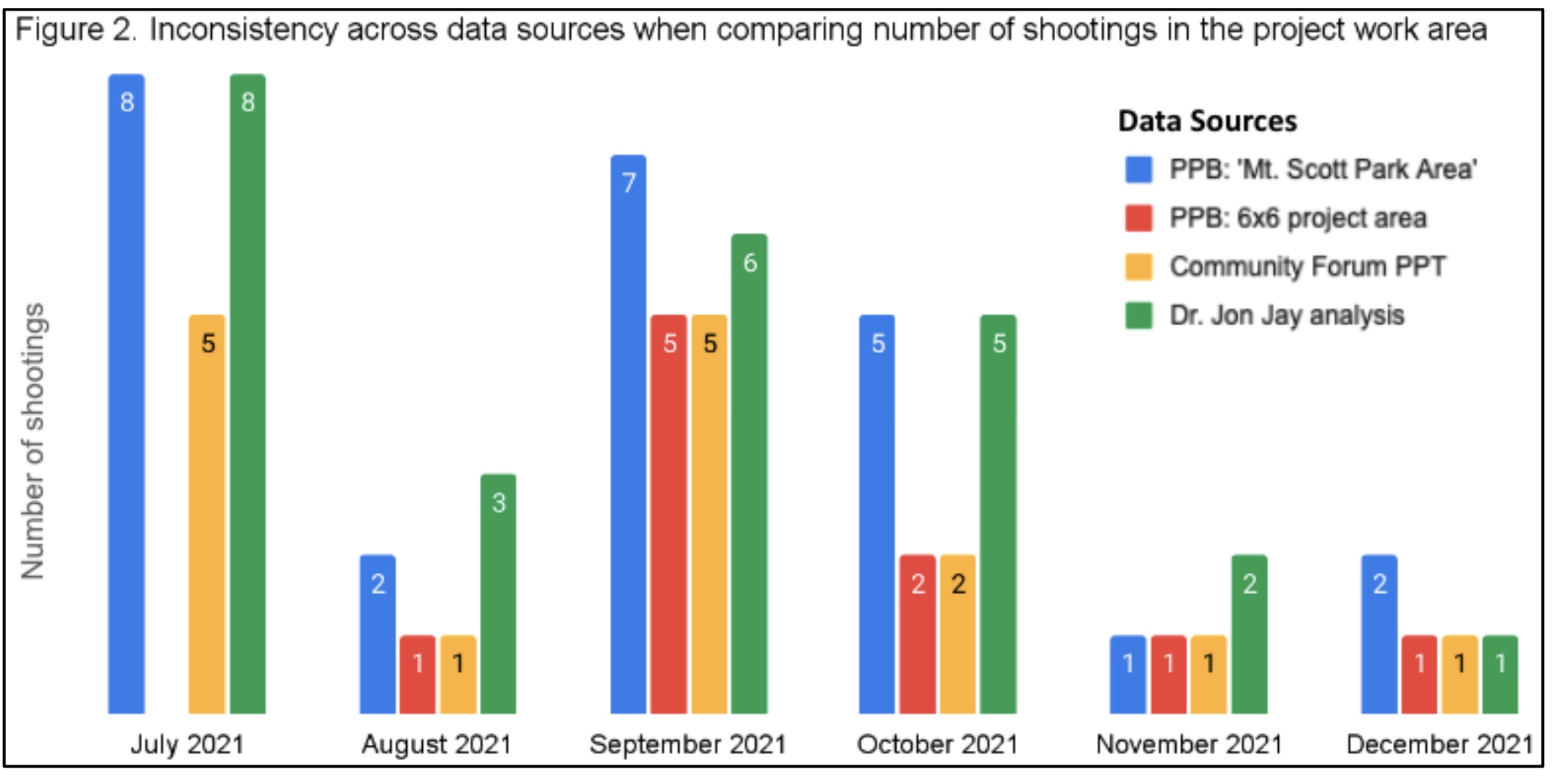
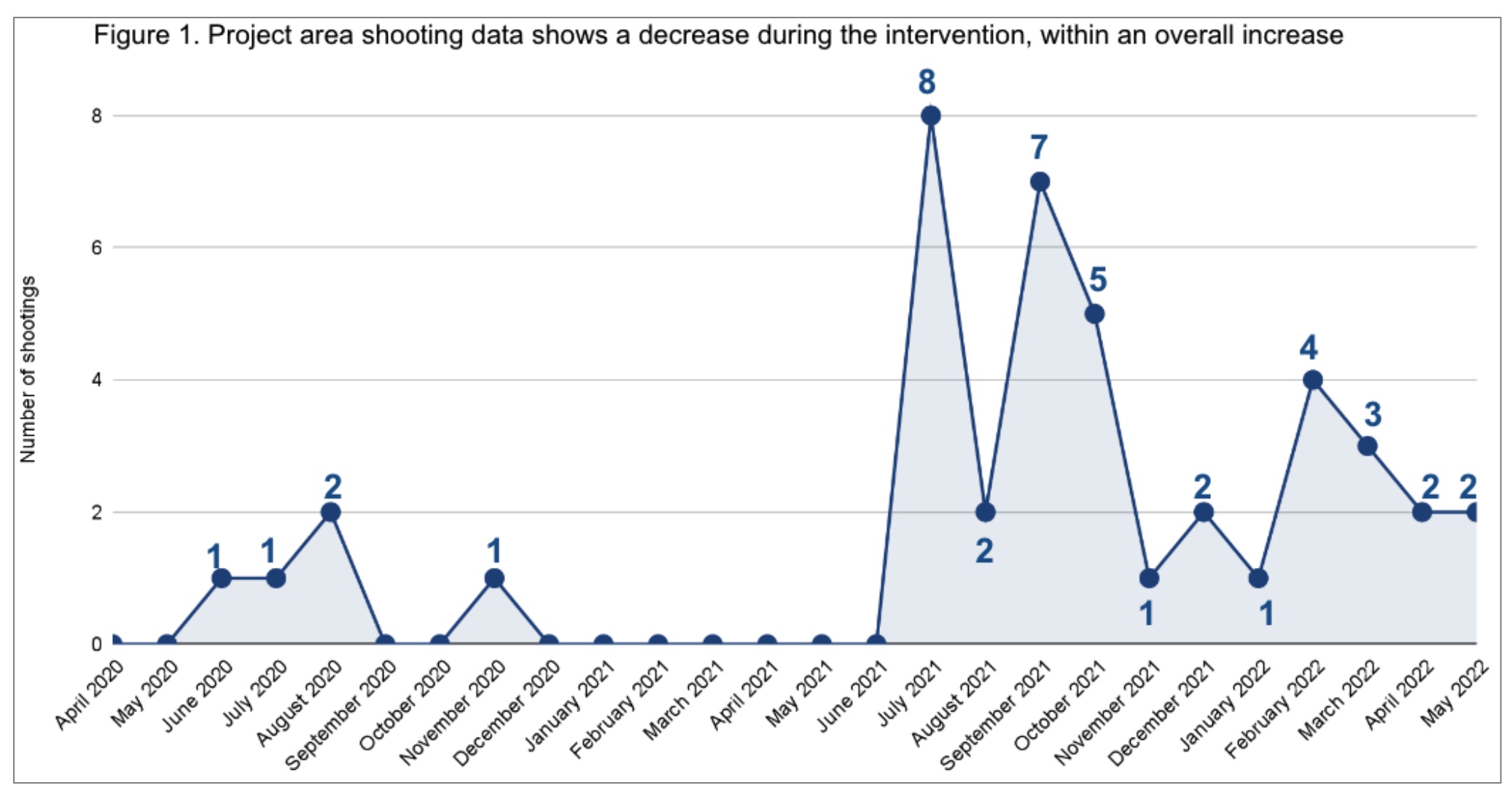
“Findings are promising and suggest that the project may have contributed to the decrease in shootings during the project timeline. Analysis of Portland Police Bureau (PPB) shooting data shows the number of shootings decreased in the ‘project area’ (where joint patrol missions with Portland Parks & Recreation took place) during the implementation timeline (Sept-Dec. 2021) – within a trend of overall increase. An increase in shootings post-intervention suggests the intervention may [have] had an impact, and this demonstrates the need for the project to continue with more comprehensive data analysis to determine outcomes.
Challenges to determine whether the intervention caused or contributed to the change include that statistically; shootings decrease in the summertime, there is inconsistency in reporting the number of shootings per month, and it is unclear how the project work area was defined by all sources.”
I asked Lisa Freeman, a program manager at the OMF Community Safety Division, for a bit more context. She said after the initial analysis, the city wanted an external evaluation to more carefully review the project.
“The external evaluation largely validated the findings reported in March,” Freeman shared. “And was able to more comprehensively document the project, process of implementation, and offer recommendations for future activities.”
That “future activities” part is important because while we can debate the statistical impact of this approach, there’s no debating that the City of Portland plans to double-down on it. Mayor Ted Wheeler likes the approach so much he made it one of the focus areas of his new gun violence reduction plan.
Yet while the main takeaway is positive, the report lists several potential pitfalls as the city looks to continue and expand this type of work: Communication strategies need to improve so there’s not another (inaccurate and click-baitey, yet understandable) “orange barrels to reduce gun violence” news cycle; local volunteer time cannot be taken for granted; asking PPB officers to work overtime is unsustainable (and politically unpalatable); and more BIPOC and non-English speaking community members need to be included in the planning.
Look for this project and others citywide to become more common as more Portlanders realize that many of our public safety problems are interconnected, and bureaus like parks and transportation can have just as much impact as police.
Check out the project summary or full report.



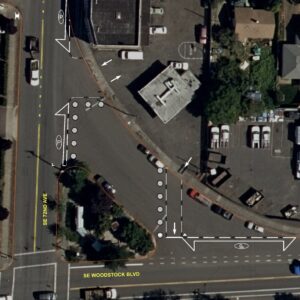
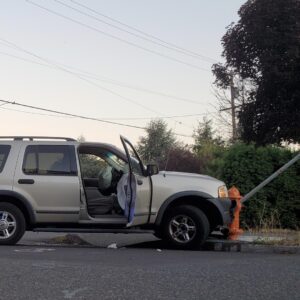

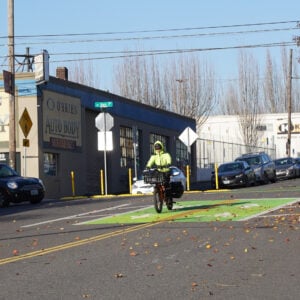
Thanks for reading.
BikePortland has served this community with independent community journalism since 2005. We rely on subscriptions from readers like you to survive. Your financial support is vital in keeping this valuable resource alive and well.
Please subscribe today to strengthen and expand our work.
I live in this neighborhood. Almost every night we have the “gunshot or fire works?” conversation. Sure, the bunch of orange plastic barrels provided a temporary solution, but there’s been far too much self-congratulation and back-slapping by the city about them. Especially when the whole thing was driven by desperate residents.
FWIW, near me, the barrels are mostly moved to the side of the road within hours. Or used as targets. What PBOT needs to address is the appalling road design in this area. For example, Woodstock is a long straight road with no crosswalks for 20 blocks, no incentive not to speed, not even bus stops to slow things down. There is a total lack of action on the dangerous junctions at 65th and at 68th, where we see frequent crashes, The bike lane fades in and out and is a perfectly horrible ride.
Heavens we don’t even have bike share here, and we sure could use it.
The contrast with the way the city jumped to fix problems *permanently* in NW (where I used to live) is stark.
Thanks Fiona. I hear you loud and clear. Points taken. Too much back-slapping has been a big problem in this town for as long as I can remember and I agree we need to be wary of it.
I was hopeful when I saw Dr. Jay did some analysis, but this is still insufficient. Really wish they hired a consultancy with a statistician on staff.
They need need NEED to include a control neighborhood. Don’t just do pre/post in Mt. Scott — pair that with a pre-post in a random selection of comparable neighborhoods that didn’t receive the intervention at the same time. What happened in Lents during this period? Give us context!
Bingo. This is meaningless without a control group. This is basic stuff.
Nonsense – The logical extrapolation is to double the number of cones in the same area to double the results.
If I was to choose a set of control group neighborhoods, I would not choose Lents, it’s too big and too strange. I’d instead choose neighborhoods of similar size and economic status. Mill Park comes to mind, maybe Park Rose Heights or Brooklyn, and a couple in NE or North Portland.
https://www.michellehelman.com/about.html
EDUCATION
MA Political Science: Peace & Conflict Studies
University of Queensland, Australia (2019)
BA Liberal Arts & Social Science: Anthropology
University of Illinois at Urbana-Champaign, USA (2005)
Her mission statement is hilarious, she basically apologizes for being alive.
The consultants aren’t qualified to evaluate experimental design or to make recommendations about what is required to reach statistical significance, although that’s probably not possible with the limited amount of money available to study this.
My hunch is that Dr. Jay contributed a lot to the the analysis portion of this report, which basically says they don’t have enough data to say anything.
I wish the city would create a small statistical group, along the lines of the City Attorney’s office but smaller, as a resource for all the managers, bureaus and electeds who want the gravitas that data analysis lends, but don’t know anything about it–as in they don’t know what they don’t know.
I assume this consult hire came through Hardesty’s City office:
RE: I wish the city would create a small statistical group, along the lines of the City Attorney’s office but smaller, as a resource for all the managers, bureaus and electeds who want the gravitas that data analysis lends, but don’t know anything about it–as in they don’t know what they don’t know.
Lisa, I think this is an excellent idea! As I touched on in my note to you, Taylor, and Jonathan yesterday, for most of my career in IT I worked as a metadata and data geek (administrator, analyst, modeler, architect). At every company and public agency where I worked, there were teams dedicated to addressing what you’ve described. In most cases, the teams operated as cost centers and served the entire enterprise (corporation, division, agency).
I don’t know how the city’s IT departments are organized, but (IMO) if they don’t have centralized data functions as I’ve described and you suggest, then data silos and fiefdoms can occur, master data definitions and sharing become problematic, and so forth. I’d extend that assertion to Metro and our three counties as well.
All that said, I found that the centralized vs. decentralized staffing model occasionally changed during reorgs/RIFs. I don’t miss those days.
Mark, we are probably dating ourselves. I started my career at the “Biocomputing Unit” of a medical school/research center. (My boss was British, hence the “unit.”)
We operated like a secretarial pool of for-hire programmers, you paid for one of us, you got one of us. Plus we had the advantage of not being isolated, we could ask advice of one another.
So yeah, I’m imagining a small group of analysts/statisticians who could advise city employees.
To an elected commissioner, the point of any report is to support their policies and to dismiss those of their potential rivals.
The city has a centralized GIS group called Corporate GIS for all the bureaus, they do a lot of data analysis as well, statistics, etc. The “elected” City Auditor and her office does even more in-depth statistical studies and often writes very scathing reports about how various bureaus and elected commissioners completely fail to do what they set out to do. They make good reading – I highly recommend their reports for any member of the public (including the press) who are looking to learn exactly how the city really works.
This is very bureaucratic, but each commissioner has their own budgets and hires that are outside the general civil-service sets of bureaus, so even if there is a sound centralized city statistical agency, there’s a very strong possibility that each commissioner and the mayor may be unable to use it, even if they felt so inclined to do so (which in my opinion is doubtful).
RE: The “elected” City Auditor and her office does even more in-depth statistical studies and often writes very scathing reports about how various bureaus and elected commissioners completely fail to do what they set out to do. They make good reading – I highly recommend their reports for any member of the public (including the press) who are looking to learn exactly how the city really works.
Thank you, David, for providing this helpful background information. I’ve come to really appreciate your experience-based insight and thoughtful commentary on BP.
I think public auditors, at all levels, serve a critically important role in monitoring governmental operations. I think investigative reporters can have an important role as well.
I’m looking forward to our new city auditor, Simone Rede, taking office in January. I enthusiastically voted for her.
In local government organizations that I know it’s typically the person who has the connections but not the qualifications that gets put into the “fancy bar and pie charts” group, because after all, if you can create a spreadsheet that makes you qualified to do statistical analysis right??!
It was learned that you never took what they produced seriously.
Lisa, I agree: city policymakers need to be able to easily tap the expertise of statisticians, ones who are skilled in data analysis and capable of “translating” their findings into terms non-experts can grasp.
I read the report. I’m distressed that you continue to be in awe of anything from Comm. Hardesty’s office.
You state “the project appears to be having a positive impact.” The report says “Preliminary findings are promising and suggest that the project may have contributed to the decrease in shootings during the intervention timeline.” It’s subtle, but your statement seems more positive than the report’s wording. A “suggestion” that the project “may have contributed” doesn’t equate to “appears to be having a positive impact.
Sorry. This does not do anything to persuade me that the construction barrels have done anything to reduce gun violence.
“…shootings decrease in the summertime….” ??? Isn’t this exactly the opposite of what we actually know about American cities? (See https://www.nytimes.com/2018/09/21/upshot/a-rise-in-murder-lets-talk-about-the-weather.html )On the bright side, that would mean it’s _more likely_ the pilot made a difference.”